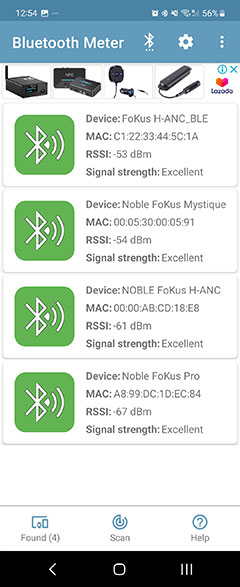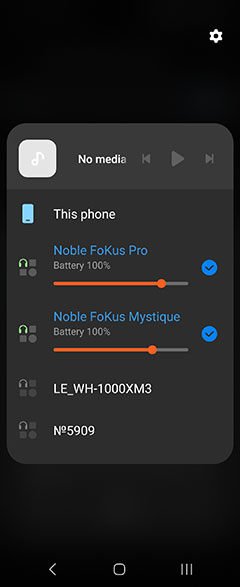Sound Impressions
Summary
The FoKus Mystique is not better or worse sounding than the previous FoKus Pro, rather it just ‘hits differently’.
Depending on your preference that can be a pro or a con but for me the technical capability of the new version is every bit as good as the original Pro. In short, it is one of the best-sounding True Wireless Systems out there in the market right now.
What we have now is a shift more to a slightly v-shaped response with a drop back in the midrange emphasis, a slightly warmer timber, especially on the lows to lower mids and a generally more expansive sound signature.
The bass reaches deeper, with some improved sub-bass elevation and body. The treble extends a little more with some upper treble emphasis which casts some improved shimmer and contrast on the upper mids timbre.
Vocal positioning will depend largely on the pitch but generally female vocals will come across as more focused and pure sounding than lower register chest or male vocals.
That being said lower pitching vocals will sound a little bit warmer and with a stronger fundamental and almost all benefit from the FoKus Mystique’s better use of space, (more open sounding), compared to the Pro.
If anything the FoKus Mystique tuning is more ‘modern sensitive’. By that I mean it does better at fleshing out some of the key touch points in modern music with excellent depth, a firmer fundamental for rhythm, and improved headroom and space for subtle notes to resonate clearly.
Frequency Response
I initially stated that the FoKus Mystique is more v-shaped compared to the Pro version but I need to emphasize that it is not an exaggerated V-shaped curve like CA’s Orbit.
There is more mids presence here just not as much as the Pro which has more pinna gain with a fleshier front and center vocal presence and generally a more intimate staging quality as a result.
I would say the midrange curve of the Mystique is more akin to how they shaped the Viking Ragnar with a rising lower mids and a gentle life around 1-2k that stays relatively neutral to 4k and slightly south of the recommended Harman Target curve level.
The low-end up to around 50-80Hz sounds more elevated compared to the Pro but consequently, the mid-bass to lower-mids is slightly reduced creating an increased perception of bass-to-mids separation. It is not as aggressive or as punchy as the Pro bass tuning but sounds fuller right at the very lowest register.
From around 300-400Hz to around 1-2k there is gentle life fleshing out a better lower mids presence and helping inject some necessary warmth and a good fundamental into both chest vocal pitches and supporting instruments.
On the flip side, the FoKus Mystique treble emphasis has been shifted a little more towards a stronger 6-8k lift so it carries a more ethereal tone with improved shimmer and a bit more contrast on the upper mids timbre.
Timbre
The Fokus Mystique offers a very planted steady sounding bass fundamental with some warmth in the lower-mids instrumental timbre and a slightly more ethereal lighter note quality through the upper mids and highs.
You could argue it is generally the warmer of the two when compared to the Pro though some might state the Pro has the more accurate midrange timbre with a fuller fleshier note for vocal performances.
True enough, some FoKus Mystique vocals can sound a little lighter in weight but they also benefit from a lot more space around them. Throw in that little bit of additional upper treble overtone and you get some nice contrast in its harmonic balance and a welcome level of clarity to go along with it.
It works especially well with slower-paced tracks heavier on string and percussion layering. Acoustic bass plucks, hi-hat slaps and drum brush hits sound finely balanced between weight and snap, neither too sharp nor too dull in their presentation.
Staging & Dynamics
You have to keep the FoKus Mystique paired to a source that will take advantage of its aptX capability to get the very best out of the drivers’ dynamic range.
Pairing with an iPhone 13 Mini and switching to AAC sucked a lot of vibrancy out of the performance and in turn, it also noticeably shrunk the staging dimension giving the FoKus Mystique presentation more of a one-dimensional quality.
Paired with a Samsung Z Flip 3 in aptX mode you will immediately notice an improved holographic soundstage, with much better imaging as well as sounding far more resolving and less compressed in its delivery.
In aptX mode, the imaging is excellent for a TWS, helped along by the stronger perception of space and distance from the stage compared to the Pro version which brought everything right up in front of you. Instruments are less tucked in behind the vocal imaging and more alongside and out a bit wider as a result.
Depth is very good also. Perhaps not to a good wired IEM level but you can pick up on the additional lower register weight without muddying up the mids or overpowering them. The separation and layering here are impressive so you get the power but not an overbearing amount of it.
Wireless Performance
Pairing
Pairing is pretty slick with the FoKus Mystique but that was the case also with the FoKus Pro before it so it’s a very similar experience.
Simply open up the TWS cradle, take them out, and wait for the pairing status from the voice prompt then scan with your chosen BT transmitting sources such as a smartphone, iOS platform, or DAP and it should come up as “Noble FoKus Mystique” in the BT scanning list.
From there just hit pair and once confirm both drivers should activate and be ready to play.
Potential hit-and-miss scenarios? Well, I would be careful about pairing more than one TWS at a time with certain smartphones that can multi-point as they can drop the decoding quality from aptX down to SBC.
A good example of that is the Samsung platform which will allow you to deliver audio to multiple BT devices at the same time. Upon connecting both the FoKus Mystique and the Pro models simultaneously the codec dropped to SBC.
Even if you disconnect one TWS it will stay in SBC so you need to turn off BT on the phone completely and restart it and pair again before the FoKus Mystique will work in aptX mode.
Stability & Range
I actually think the FoKus Mystique has improved its overall stability and range over the Fokus Pro. Not a huge difference but once you got to about 10-12 meters with 1-2 barriers in between the Pro signal using the Samsung Z Flip 3 got noticeably choppier before the Mystique signal gave up the ghost.
A quick quantitative measurement actually did seem to suggest that the signal strength of the Fokus Pro is a bit weaker than the equivalent signal inside the Mystique by around 5-6dBms from 1-2 meters away which is the range within which most people will be operating their pairings.
Switching down to an Apple iPhone 13 Mini using AAC the gap was closer but still overall a slightly more uneven signal range from the FoKus Pro. The SBC-capable GeekFly GF8s was slightly ahead of the FoKus Pro but just behind the FoKus Mystique in terms of overall stability.
The cheaper FoKus H-ANC did slightly better than the FoKus Pro with a very minimal difference between it and the Mystique though to be fair I had run out of space in our apartment to walk any further away than around 13-14 meters.
Latency
Via a PC using VLC, the FoKus Mystique is one of the tighter aptX-equipped TWS performers though you still might need around 0.01. to 0.02s of hastening in VLC’s sync dashboard to get it super tight. That being said without any sync adjustments it was not as loose as something like the CA Orbit performance we reviewed a few days earlier.
For smartphone and iOS platforms using YouTube, the lag is not noticeable. In fact, it was quite tight with both a Samsung Z Flip 3 in aptX mode and the Apple iPhone Mini 13 using AAC so I would feel quite comfortable recommending the FoKus Mystique for casual media consumption from portable devices.





